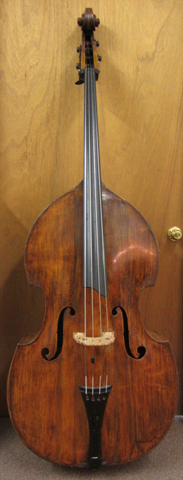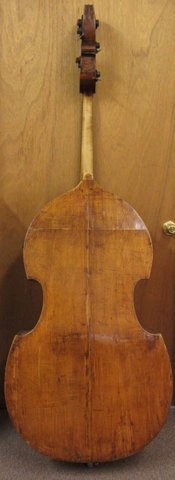 |
 |
 |
A beautifully proportioned Orchestra/Solo or Jazz Bass with a traditional Viennese Scroll/Pegbox as used in the 18th & 19th centuries.
| Viennese School Vienna c.1880 |
 |
 |
 |
A beautifully proportioned Orchestra/Solo or Jazz Bass with a traditional Viennese Scroll/Pegbox as used in the 18th & 19th centuries.
| 3/4 Viennese Bass ~ (in restoration) | |
| Upper Bout: 20 1/2" | Body Length: 42 1/2" top, 44 1/4" back |
| Center Bout: 14 1/2" | String Length: 41 1/4" |
| Bottom Bout: 25 3/4" | Varnish: Golden Brown |
| Rib Depth: 8" (6 5/8" at Neck) | |
| Top: Spruce | |
| Back: Maple | |
| Ribs: Maple | |
| Neck / Scroll: Beechwood with Flamed Maple Neck Graft | |
Features: Here is a beautiful old Viennese/Prague style bass. In researching this bass originally, we found one that was labeled "Joseph Anton Laske, Prague 1788" and then another near identical bass labeled "Eduard Heidegger, Linz 1877". With nearly a century between the two basses of the same model, what is one to think? Well, the condition of the Linz bass looked far younger than the Prague bass. The Laske labeled bass and this Prague bass here are more similar in age. I have also since found a few more basses of similar design and scrolls combined which was what connected them in the first place. I also have a book with two actual Laske basses pictured, but they look older in design than all of theses basses. So, I think the labeled Laske bass is possibly incorrect and the Heidegger bass from Linz is actually a Prague made bass with the dealer's label in it like you would find with imported basses from Hawkes to Morelli to Juzek. Basses made by others for the trade by design. All of the Bina basses I have seen pictured had purfling on the Back and Top. All other 18-19th century Prague and Viennese basses I have seen for the most part do Not have Purfling on the Back. Also, the Violone Scrolls with the fully pointed cheeks like this come in two styles but look alike from the front and sides but different in the back. The Viennese pegboxes are fluted from the front of the head and run down the back of the 'box to the pointed mound. The Prague basses are only fluted over the head, but the entire back of the 'box is left flat. I discovered this after comparing over a dozen scrolls from both schools. There are other versions of these scrolls in all of these countries as well as regular scrolls but with the old style Violone scroll, this is the main difference I have found between basses made in Vienna and the Viennese style basses made in Prague. Searching this Bass and its origin has come down to the Gears that are original to the Bass. I have seen a few Viennese Basses with these gears that look exact or very similar with the Almond shaped handles. I have never seen a confirmed Prague Bass with the Almond handles. The fluting on the back of the pegbox is more Prague style than Viennese BUT, I have seen a Schweitzer Bass that is the same in both details, fluting and gears. Schweitzer trained in Vienna where he was born but soon moved to Budapest (Pest), Hungary (about 150 miles from Vienna). His work merges the Austro-Hungarian flavor combining features of both areas. Schweitzer trained with Geisenhof in Vienna who was the successor to J.G. Thir. When I first saw this Bass, it reminded me of an old Thir Bass I had seen about10 years earlier but was an older Bass from the previous century. If only all of the Basses of the worlds makers were pictured in one reference book, we would all be smarter in this regard. |
|
 |
Copyright © 2018 Ken Smith Basses, LTD. (All rights reserved) ALL PRICES AND SPECS SUBJECT TO CHANGE WITHOUT NOTICE |
 |